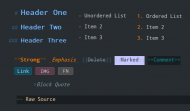Why have I never heard of
Inspire Writer?
(I suppose another way of thinking about it, is 'how did I hear about it now?' and I'm not sure I can answer that either.
It's a minimalist wysiwygish markdown editor.
And I really mean minimalist. Minimalist in looks, minimalist in features and virtually no settings that can be tweaked. Though not minimalist in cost - it's not expensive but it
is paid software whereas most markdown editors on Windows are free. $30 atm, same price as iA Writer.
Many similarities to iA Writer and Ulysses to my untutored eye as a non-Mac user who tried the iA Writer trial, but never felt any value in using it. It feels as if there's a macness about it. I like the dark theme (which is what I use) much better than the iA Writer theme which always felt to starkly black and contrasty. This one is remarkably similar in tone to my preferred theme on Obsidian (Obsidian Nord).
- It has typewriter mode, but no focus mode apart from making the edit pane full screen.
- It has import from docx, HTML. I didn't try HTML, but the docx imports never worked.
- There's no ability to move files around, or headers around in the outline.
- There's no folding on headings (and it accepts a #heading instead of requiring # heading).
- There's no way to have more than one file open at a time that I could find - only one window, no tabs, only one pane.
- Switching view modes is slow. Slower than any markdown editor or word processor I have used before. Usable, but noticeable.
- The markdown syntax it has available is very limited.

- But does have images, tables etc working simply enough
- Only two themes (light and dark). I suppose the light theme is okay, but don't use them so can't compare. I do like the dark theme.
Looking at the above, it looks much more limited than all the free editors I, and most people, use.
So why would anyone consider paying money for it? Well, it actually looks like a neat little editor for writers. It has the necessary features (
bar underline and folding) but isn't weighed down by the tonnes of useless garbage most markdown editors smother themselves with. It looks nice and easy on the eye (though would benefit from
a focus mode - FocusWriter would be a good implementation; maybe adding a sentence option). There are four predefined tags - Urgent, ToDo, Draft and Published - which points to writers being their target market.
And it does have useful features.There's an option for live spellchecking in up to three languages (not that this is something I often turn on).
There are statistics for selection and whole document (characters, sentences, paragraphs, pages - though I'm not sure how the pages are calculated).
There's a comment syntax (++ for a line/section; %% for blocks)
There's a very nice set of export options - Ghost, Medium, WordPress (+ PDF & HTML) and especially .docx. I really like this one. It presents the option of exporting into a number of styles (Modern, Elegant, Formal etc), allows a preview, and then the options are to save, to put into clipboard or to open in a selected program - such as Word. So no need to create documents if that's not needed, which suits my Workflowy purposes ideally - though I still need to do my copying from Word itself to get the paragraphs I need - Enter appears to = New Paragraph; with Shift-Enter = New Line, but the 'paragraphs' are really markdown lines, and the new lines are soft line breaks.
Autosave is quite fast (at least in external files) and it has a regular backup schedule.
So all that's quite nice. And all of that is for files living in the file explorer, being shared with other editors. There are a few more features, for those files created in or imported to the Library. (
I assume that the library is some type of database. Imported files stay where they are, there's just a new copy created in the library; the new copy is not synchronised with the original file.)
Possibly the most important of these is that the files in a Library folder can be moved around the sequence easily and that individual files can be selected for export using the usual Ctrl or Shift options, which makes it very easy to put together a long document/book for export to Word or PDF. These 'sheets' can also be split or merged as desired.
There's also a note/sticky note feature (only one per sheet) and session word counts (and goals).
Do I like it?Yes I do. Despite the lack of folding, I can imagine using it as my main writing interface. The export options to Word are great. It's very simple; all the options it has are useful to me (most writers, I imagine) and there's nothing else getting in the way. For those that want them, the Scrivener like scene/chapter/book type options seem functional. It happily works as a normal markdown editor on external files as well as those in its database, though with slightly fewer features (I think its file explorer gives it an advantage over WriteMonkey 3 in this regard). I'm happy to buy it for my writing and happy to use the other editors for notes and anything that needs their more advanced capabilities.
I came across the following
review, which specifically compares it to Ulysses, so I feel that my impression of macness is probably on the mark.

 Recent Posts
Recent Posts